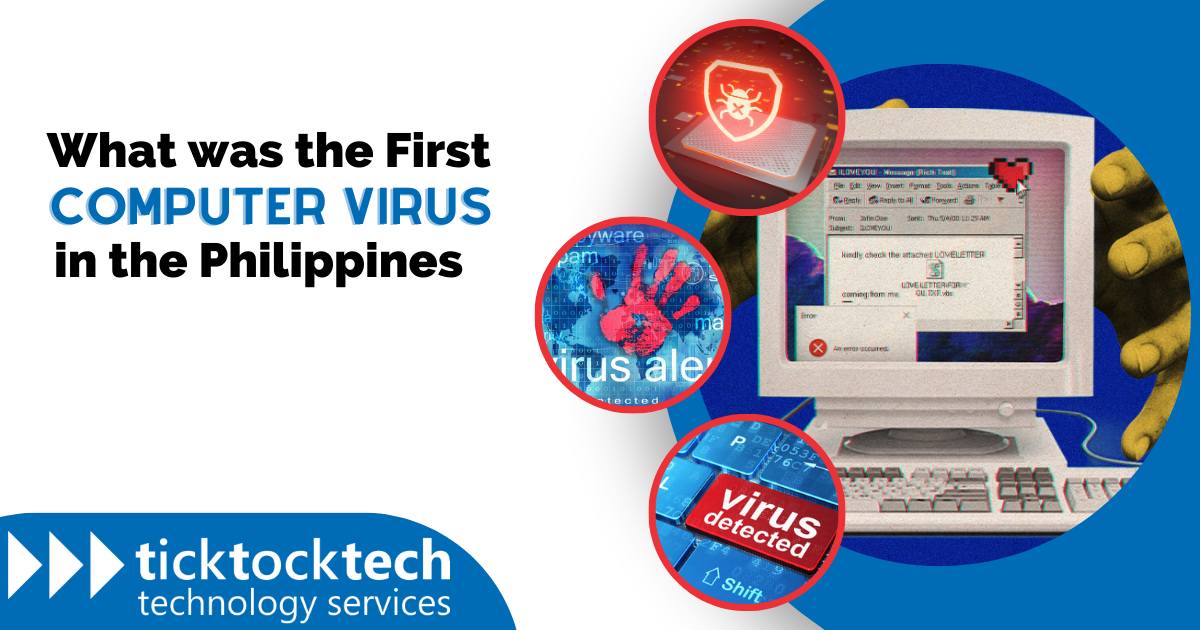Uncovering The Origin: The Pioneering Computer Virus In The Philippines
What was the first computer virus in the Philippines called? The Mariposa Virus.
The Mariposa Virus was the first computer virus to hit the Philippines in 1998. It was a file infector that targeted Windows 95 and 98 systems. The virus would attach itself to executable files and then spread to other computers when those files were opened. The Mariposa Virus caused widespread damage, infecting millions of computers worldwide and causing data loss and system crashes.
The Mariposa Virus is a reminder of the importance of computer security. It is essential to keep your software up to date and to use a reputable antivirus program to protect your computer from viruses and other malware.
Here are some of the main topics that we will cover in this article:
- What is a computer virus?
- How does a computer virus work?
- What are the different types of computer viruses?
- How to protect your computer from viruses
What was the first computer virus in the Philippines called?
The first computer virus in the Philippines was called the Mariposa Virus. It was a file infector that targeted Windows 95 and 98 systems. The virus would attach itself to executable files and then spread to other computers when those files were opened. The Mariposa Virus caused widespread damage, infecting millions of computers worldwide and causing data loss and system crashes.
- Name: Mariposa Virus
- Type: File infector
- Target: Windows 95 and 98 systems
- Spread: Attached itself to executable files
- Damage: Data loss and system crashes
- Year: 1998
The Mariposa Virus is a reminder of the importance of computer security. It is essential to keep your software up to date and to use a reputable antivirus program to protect your computer from viruses and other malware.
Name
The Mariposa Virus was the first computer virus to hit the Philippines in 1998. It was a file infector that targeted Windows 95 and 98 systems. The virus would attach itself to executable files and then spread to other computers when those files were opened. The Mariposa Virus caused widespread damage, infecting millions of computers worldwide and causing data loss and system crashes.
The Mariposa Virus is a reminder of the importance of computer security. It is essential to keep your software up to date and to use a reputable antivirus program to protect your computer from viruses and other malware.
Here are some of the key insights that we can learn from the Mariposa Virus:
- Computer viruses can be very damaging, causing data loss and system crashes.
- It is important to keep your software up to date to protect your computer from viruses.
- Using a reputable antivirus program can help to protect your computer from viruses and other malware.
Type
The Mariposa Virus was a file infector, which means that it attached itself to executable files and then spread to other computers when those files were opened. This type of virus is particularly damaging because it can infect multiple files on a single computer, and it can also spread to other computers very quickly.
File infectors are one of the most common types of computer viruses. They are relatively easy to create, and they can be very effective at spreading and infecting computers. File infectors can also be used to deliver other types of malware, such as ransomware or spyware.
It is important to protect your computer from file infectors and other types of malware by using a reputable antivirus program. Antivirus programs can scan your computer for viruses and other malware, and they can also block malicious files from being downloaded or opened.
Target
The Mariposa Virus, the first computer virus in the Philippines, specifically targeted Windows 95 and 98 systems. This was due to the popularity of these operating systems at the time, particularly in the Philippines. The virus exploited vulnerabilities in these systems to spread and infect computers.
- Widespread use: Windows 95 and 98 were widely used in the Philippines, making them a prime target for the Mariposa Virus.
- Security vulnerabilities: These operating systems had vulnerabilities that the Mariposa Virus could exploit to spread and infect computers.
- Lack of security awareness: At the time, many computer users were not aware of the risks of computer viruses, which made it easier for the Mariposa Virus to spread.
The Mariposa Virus serves as a reminder of the importance of keeping software up to date and using a reputable antivirus program to protect computers from viruses and other malware.
Spread
The Mariposa Virus, the first computer virus in the Philippines, spread by attaching itself to executable files. This means that when a user opened an infected executable file, the virus would be copied onto their computer and would then spread to other executable files on the system. This made the Mariposa Virus very effective at spreading and infecting computers, as executable files are commonly used to run programs and applications.
The spread of the Mariposa Virus highlights the importance of understanding how computer viruses work and how to protect against them. By understanding the different ways that viruses can spread, we can take steps to protect our computers and data from infection.
Here are some key insights that we can learn from the Mariposa Virus:
- Computer viruses can spread in a variety of ways, including by attaching themselves to executable files.
- It is important to be aware of the different ways that viruses can spread so that we can take steps to protect our computers and data.
- Using a reputable antivirus program can help to protect your computer from viruses and other malware.
Damage
The Mariposa Virus, the first computer virus in the Philippines, caused significant damage to infected computers. The virus could cause data loss by corrupting or deleting files, and it could also cause system crashes by damaging critical system files.
- Data loss: The Mariposa Virus could infect and corrupt files, rendering them inaccessible or unusable. This could lead to the loss of valuable data, such as documents, spreadsheets, and photos.
- System crashes: The Mariposa Virus could also cause system crashes by damaging critical system files. This could make it impossible to use the computer until the system files were repaired or replaced.
The damage caused by the Mariposa Virus highlights the importance of protecting computers from viruses and other malware. By using a reputable antivirus program and keeping software up to date, we can help to protect our computers and data from damage.
Year
The year 1998 holds significance in the history of computer viruses in the Philippines as it marked the emergence of the Mariposa Virus, the country's first known computer virus. This event brought to light the growing threat of cyber threats and highlighted the need for increased vigilance and protection measures against malicious software.
The Mariposa Virus targeted Windows 95 and 98 operating systems, which were widely used at that time, particularly in the Philippines. The virus spread rapidly, infecting numerous computers and causing significant data loss and system crashes. This incident served as a wake-up call, prompting individuals and organizations to prioritize computer security and adopt proactive measures to safeguard their systems.
The emergence of the Mariposa Virus in 1998 underscores the evolving landscape of cyber threats and the importance of staying informed about the latest security risks. By understanding the historical context and impact of this event, we can better appreciate the significance of cybersecurity and the ongoing efforts to protect computer systems and data from malicious attacks.
The emergence of the Mariposa Virus in the Philippines in 1998 marked a significant event in the country's cybersecurity history. To provide a comprehensive understanding of this topic, we have compiled a list of frequently asked questions and answers:
Q1
A1: The first computer virus to hit the Philippines was called the Mariposa Virus.
Q2
A2: The Mariposa Virus emerged in 1998.
Q3
A3: The Mariposa Virus was a file infector, meaning it attached itself to executable files and spread when those files were opened.
Q4
A4: The Mariposa Virus targeted Windows 95 and 98 operating systems, which were widely used in the Philippines at the time.
Q5
A5: The Mariposa Virus caused significant damage, including data loss and system crashes.
Q6
A6: The Mariposa Virus highlights the importance of cybersecurity, keeping software up to date, and using reputable antivirus programs to protect against malicious threats.
By understanding the answers to these common questions, we can gain a deeper understanding of the significance of the Mariposa Virus and its impact on the Philippines' cybersecurity landscape.
For further insights into computer viruses and cybersecurity, please refer to the next section of our article.
Conclusion
The Mariposa Virus, the first computer virus to hit the Philippines, serves as a stark reminder of the growing threat of cyber attacks and the importance of cybersecurity. This incident highlights the need for individuals and organizations to prioritize computer security measures, including keeping software up to date, using reputable antivirus programs, and educating users about cyber threats.
As technology continues to advance and cyber threats become increasingly sophisticated, it is crucial for us to stay vigilant and proactive in protecting our computer systems and data from malicious attacks. By understanding the history and impact of computer viruses like the Mariposa Virus, we can better appreciate the significance of cybersecurity and the ongoing efforts to safeguard our digital world.



Detail Author:
- Name : Kavon Mante
- Username : schumm.kathryne
- Email : unienow@roob.net
- Birthdate : 2000-08-13
- Address : 22251 Jay Brooks Edwardomouth, TN 71838-9620
- Phone : +1-262-487-6793
- Company : Predovic-Schinner
- Job : Architect
- Bio : Iste iure quos sunt at mollitia. Laboriosam sapiente alias autem quae voluptates velit odio. Eos sit quam nostrum quasi maiores. Velit ad minima et nihil veniam sint exercitationem.
Socials
tiktok:
- url : https://tiktok.com/@raynork
- username : raynork
- bio : Aut velit enim temporibus reiciendis fugiat. Et ex quis sunt magni tempore id.
- followers : 5388
- following : 65
instagram:
- url : https://instagram.com/khalid_raynor
- username : khalid_raynor
- bio : Voluptatibus eum sequi fugiat mollitia. Praesentium quia minus dolor est.
- followers : 438
- following : 2012